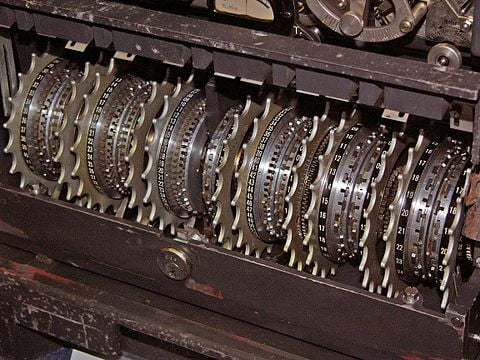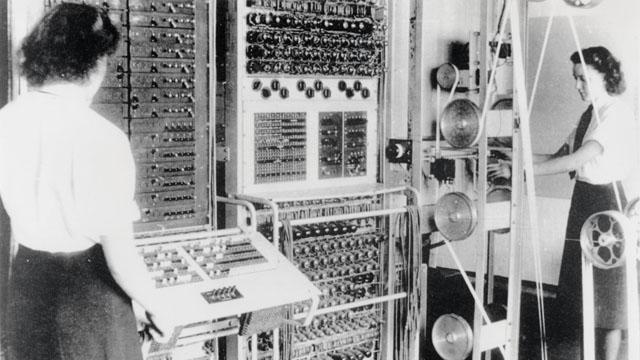The Bletchley story is a fascinating one.
But no story within that overall story is more intriguing than that of Tommy Flowers.
Here was a man who believed that one could build a programmable computer; and he invested his own money to make this vision happen with very little support from the wartime British government.
After his investments and the work of his team clearly identified the possibilities, support started to come to the team.
What would be built was the first programmable computer, Colossus.
And that new capability would come none to soon.
In addition, the various Enigma codes, the Germans had shifted much of the higher-level command communications to a much more sophisticated machine, one which simply could not be cracked rapidly enough to matter to operations.
That is without the building of Colossus and its enormous for the time capability to process data.
The Colossus computers were used to help decipher intercepted radio teleprinter messages that had been encrypted using an unknown device. Intelligence information revealed that the Germans called the wireless teleprinter transmission systems “Sägefisch” (sawfish).
This led the British to call encrypted German teleprinter traffic “Fish“, and the unknown machine and its intercepted messages “Tunny” (tunafish).
Before the Germans increased the security of their operating procedures, British cryptanalysts diagnosed how the unseen machine functioned and built an imitation of it called “British Tunny“.
It was deduced that the machine had twelve wheels and used a Vernam ciphering technique on message characters in the standard 5-bit ITA2 telegraph code. It did this by combining the plaintext characters with a stream of key characters using the XORBoolean function to produce the ciphertext.
https://en.wikipedia.org/wiki/Colossus_computer

Shortly before, the D-Day invasion, Rommel sent a message back to Berlin which indicated the disposition of German forces in great detail. It was a long message.
The Colossus had only come online shortly before that but was used to decrypt this crucial message.
german_cipherAnd what was revealed was the Americans were scheduled to parachute directly on top of a German armored division!
Colossus started its operational life by saving many American lives.
Eventually, 10 machines were built but amazingly after the war, all were ordered destroyed and even more amazing Flowers was ordered to burn his drawings for the machines.
And he was returned to his former position working on Post Office research. He was never paid back for his personal investments, although given the award of 1000 pounds which he then distributed within his team, which is about as good indication of the man’s character as one could find.
And by the secrecy involved, the first programmable computer built by his team was overshadowed by MIT’s build of the “first” such machine but of course considerably after the British build of the Colossus which was of course shared with the Americans.
It is an interesting story and one which reminds us of the importance of private inventiveness to a successful national security strategy.
Something some of our big commercial firms might try to emulate the Tommy Flowers example, a life which provided a significant contribution to protecting the free world from German authoritarianism.
The country’s might change but the challenges remain.
Colossus was the worlds first programmable digital electronic (not electromechanical) binary computer.
The brainchild of Tommy Flowers, Colossus was used at Bletchley Park by the codebreakers from 1st June 1941.
Although some refer to this as the Turing machine, it was not.
Christopher McFadden in an article published on January 6, 2018 provided a very cogent tribute and recap of the life and accomplishments of this humble but extraordinary man.
Tommy Flowers is one of the greatest heroes of World War II, though many may never have heard of him. Although his profile is not as prominent as the likes if Guy Gibson or Douglas Bader, Tommy nonetheless saved many thousands of lives.
Tommy, with some help from William Tutte, designed and built the famous ‘Colossus’ computer. Historians have since argued that their combined work likely shortened the war by two years….
Such was the level doubt that Flowers was required to fund a large part the project out of his own money as well as build it on his own time. ‘Colossus’ would prove to be an extraordinary machine for the time. Its predecessor, Newman’s ‘Heath Robinson’, could read about 1000 characters a minute.
Owing to its poor reliability this would often average a lot less. The entire process needed speeding up especially as D-Day was approaching. General Eisenhower and his team needed to know as much as possible about Nazi positions in northern France.
This is where ‘Colossus’ came into its own. It could read around 5000 charactersand minute with excellent reliability….
Soon after Flowers was made a Member of the Order of the British Empire in June of 1943, he got the full backing from the Director of Dollis Hill, W. G. Radley. This backing provided Flowers and his team the highest priority for the acquisition of parts during wartime. The first fully functional machine was built with 11 months. The machines nickname is derived from the fact that the machine was very large. It seemed very fitting.
Colossus 1 performed extremely well compared to its predecessor. It turned out to be in the order of five times faster than Heath Robinson. The completed machine was finally delivered to Bletchley Park in January of 1944. Once there it was assembled and became operational in February 1944. Algorithms for Colossus were provided by Tutte and team of mathematicians.
Flowers anticipated the need for more of his programmable computers. He was already working on the improved second version, the Mark 2. This would employ double the number of valves at around 2400. Thankfully for Eisenhower and Allied high command, Colussus and its sister machine ‘Colossus’ 2 were both ready for D-Day. Both machines were up and running by the 1st of June, 1944.
This provided Allied Supreme Commanders with nearly instant access to information detected over the Lorenz System. The Nazis had absolutely no idea their code had been broken and still held their system in high regard. The information gleaned proved invaluable to the planning of D-Day. …
On one occasion, the speedy decoding of Axis communications just before D-Day on June 5th, 1944 showed that Hitler was convinced D-Day landings would occur at Pays de Calais. This comforted Allied Command that ‘Operation Fortitude’ had worked perfectly.
Hitler then refused to move troops to Normandy. This might well have saved many thousands of lives during the eventual Normandy landings.
At the end of Second World War, British Intelligence had built ten Colossus machines in total. All but two would be dismantled. These surviving machines were subsequently used at GCHQ but these too would be dismantled between 1959 and 1960. A fully functioning Colossus Mark II was rebuilt by a team of volunteers led by Tony Sale between 1993 and 2008. It is currently on display at The National Museum of Computing at Bletchley Park….
Tommy Flowers was awarded £1000 for his ‘Colossus’ invention post-war. This amount of money sadly did not cover the amount of money he had personally invested in the machine’s construction. Rationing was still in effect and would be a day to day occurrence for some time. Tommy Flowers was said to be a very humble man.
This was perfectly demonstrated when he divided the money up amongst the team who had helped him. In the end, he was left with around £350. This was a decent amount of money for 1945 but not a huge amount for the man credited with inventing the modern computer. Amusingly enough, Tommy would later apply for a loan from the Bank of England to build a Colossus-like machine. His application was denied as the bank believed the machine could not work.
Flowers, still under the Official Secrets Act, was unable to argue the case or inform them that he had already successfully built one. The post-war insanity of the Cold War would see Tommy Flowers’ work marked as highly classified. He remained under the Official Secrets Act for many years to come. It is a wonder whether he found it amusing or galling when the ‘first computer’ was announced by the Americans in 1948. Especially considering he’d created ‘Colossus’ some 5 years earlier.
The featured photo shows Wrens (members of the Women’s Royal Naval Service) at Bletchley with Colossus, the world’s first electronic programmable computer, in 1942. (SSPL/Getty Images)
For our book reviews on two leading analyses of Bletchley Park and its role, see the following:
The Secrets of Station X: How the Bletchley Park Codebreakers Helped Win the War
The Secret Lives of Codebreakers: The Men and Women Who Cracked the Enigma Code at Bletchley Park


